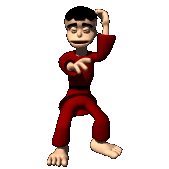
|
Shadow Form
"Actual" and "shadow" represent general tags, categorizing the underlying form. The "actual" form can be any kata, just as the "shadow" can be any shadow. For every "actual", there is a corresponding "shadow." Think of yang vs. yin, external vs. internal, action vs. spirit, manifestation vs. void. That's it! Now you're getting it. For today's consideration, we will designate Hooking Fist as the "actual" form. Hooking Fist was created by Sifu Allen Abad for his 5th Degree Kenpo (Kajukenpo) test (he is now an 8th Dan). It was actually compiled for his own teacher, Master James Ibrao. Per Sifu Abad, it is based on the Hung Gar tradition, and is intentionally simple and easy to learn, preparing the student for the related Tiger and Crane forms. Professor Abad shared it at the first Gathering of the Eagles (February 1999 in Las Vegas), and encouraged that it be further shared and incorporated into interested systems. In part, that's what we're doing here. For our purposes, Hooking Fist incorporates complex dynamic movement, over a structure of breathing oriented around the "chi belt", in a context which works balance, strength, limberness and dexterity, in a controlled format. All that, and a typical student can learn it in an hour (That's how long it took Professor Abad to teach it). That said, let's have a look at the form.
Teaching "shadow" form became necessary when I observed students working on their "actual" forms, but moving in a fashion that was completely "external". In a way, it's like taking the cart to the market and leaving the horse at home. Or you might think of it as breathing, but breathing at the chest only, and not involving one point. They were acting out the form, and doing it quite convincingly, but their energy, and root could not compare to my own. If I instructed for them to observe me closely, and incorporate what I was doing into their own execution, they would become even more external, simply doing it harder, amping up their energy investment. Of course that didn't solve the problem, it left them out of breath and tired. The objective was for my students to feel and move exactly as I did...not as they "saw" me doing. I realized the only right way to accomplish this was to create a duality where they could see both possibilities, and understand the distinction. That ultimately led to the concept of "shadow" form. Shadow Form represents the essential nature and underlying flow of the Actual Form. If you've read the Tao De Ching, you'll be acquainted with the concept of void or formlessness. In Tai Chi Chuan, formlessness actualizes into movement as Yin & Yang, and from the subsequent iterations of movement, birth is given to the ten thousand (all things). The Shadow Form is not the void, or formlessness. You might think of it as the Tai Chi of the Actual Kata, the underlying core movement and flow, and breath of what is being manifest. It emerges from the void, as a transient form, but it could be what you will. When I perform the Shadow Form, I prepare by contemplating Cheng Man Ching's rules for practicing Tai Chi. More simple and to the point are Koichi Tohei's guidelines for KI development (Principles for integrating mind and body): 1. Keep the One Point; 2. Relax Completely; 3. Keep the Weight Underside; 4. Extend
the Ki Try it. That's it...you've got the idea. Remember, accomplishing any of the four guidelines, means that all are accomplished; failing any of the four, means that all are failed. Now, let's take a look at the Shadow Form.
As you can tell, the Shadow Form parallels the movement of Hooking Fist from start to finish. Notice its effortlessness. Still, the energy is there. Can you see the points of distinction between the forms? Can you confirm one is contained within the other? That's a start! Now look even closer, if your browser allows, run them both concurrently. What do you see? Where is the real action taking place? Which one is Yang? Which one is Yin? Really Grasshopper??? Hop along now...enough work for one day! |
[Home] [About Us
] [Archie] [Concepts] [Contact Us]
[Gun
Fu Manual] [Kata]
[Philosophy] [Sticks] [Stories] [Web
Store] [Terms of Use]
[Video]
Copyright 2000-2023, Mc Cabe and Associates, Tacoma, WA. All rights reserved. No part of this site can be used, published, copied or sold for any purpose, except as per Terms of Use .
 We're going
to discuss two kata. Though different, they exist
intimately related. We will think of the first as the
"actual" form, that which others can witness on the
visual plane, as it is executed. The second will be the
"shadow" form, representing what is inside the
performer, not necessarily evident on the visual plane.
We're going
to discuss two kata. Though different, they exist
intimately related. We will think of the first as the
"actual" form, that which others can witness on the
visual plane, as it is executed. The second will be the
"shadow" form, representing what is inside the
performer, not necessarily evident on the visual plane.